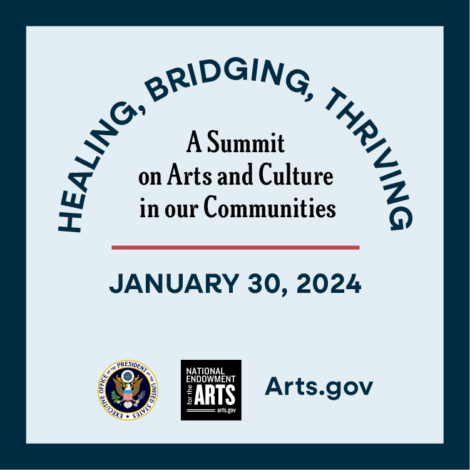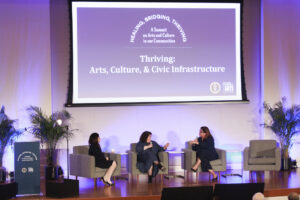From the Executive Director: Notes on “Healing, Bridging, Thriving: A Summit on Arts and Culture in our Communities”

Feb 23, 2024
by Maryrose Flanigan, a2ru Executive Director
On January 30, I was privileged to represent a2ru as one of the 500 attendees in DC for the “Healing, Bridging, Thriving” summit. The event was a landmark demonstration of the importance of arts integration, convened by the National Endowment for the Arts (NEA) and the White House. In a post-event communication, the agency reported that more than 3,500 tuned in online to watch the event.
As those in the a2ru network know, investing in the arts looks different than investing in other disciplines; and integrating the arts as equal partners in communities, institutions, and businesses is essential. Through the signals of inter-agency cooperation and showcasing the work of community organizations working with local governments, there were many positive signs from the Summit that align with your work engaging with a2ru’s mission. Here are some quick takeaways from the event:
- NEA Chair Maria Rosario Jackson opened the summit with remarks highlighting her belief “that the things we aspire to as a nation of opportunity and justice are not possible without the integration of arts and culture throughout society.” Her co-host was Neera Tanden, Domestic Policy Advisor to President Biden and Director of the White House Domestic Policy Council.
- Several programs were announced to underscore how the Biden-Harris administration values the integration of the arts, with the NEA being at the center of federal agency partnerships such as the $5M program to fund six artist residencies for the Environmental Protection Agency (EPA).
- The NEA partnered with the National Endowment for the Humanities (NEH) on a $5M project to fund nationwide campaigns to use the arts and humanities to combat hate, and to promote civic engagement with the arts and humanities at the center. You can view the NEA press release summarizing the event, as well as news coverage in the Associated Press and NPR, along with the White House Readout. For more about federal agencies deepening their commitments to arts integration: FEMA released a press release and new Fact Sheet on Art and Culture, demonstrating the essential ways that artists contribute to building more resilient communities.
- The National Assembly of State Arts Agencies (NASAA) released a cross-sector collaboration resource, a series of white papers on topics such as the arts and health for social cohesion.

U.S. Surgeon General Vivek H. Murthy.
One of my favorite moments from the summit came from a deeply personal talk from U.S. Surgeon General Vivek H. Murthy, who recounted how as a medical student he had his close observation skills honed by study of paintings in the museum close to his medical school, enhancing the students’ ability to interpret x-rays. He talked about how the focus on STEM in education should not be to the exclusion of the arts: ”We should not lose our focus on the arts because of our focus on STEM, because the arts are just as important as the sciences…they are an important part of the human experience…they help us access imagination in very different ways than the sciences and we need both of those to ….benefit humanity.” He continued, saying “[t]his is a time to revitalize the arts …not only to foster social connection but to bring hope when a lot of people are worried about the future.” His remarks reminded us that the arts are key to social cohesion and addressing the global epidemic of loneliness and its impact on health. He sees the arts as a way to rebuild social infrastructure. Drawing from his experience, he talked about how we have to broaden our concept of what healing is, and about how “The arts are a powerful source of joy, of inspiration, and of healing as a result.” An elegant reflection on this work came from World Health Organization lead Christopher Bailey and the value of his own journey to blindness and the role of creativity in it; it is an essential listen (2:07:10 in the video below), modeling how the medium is the message. Marc Bamuthi Joseph’s closing performance was also a compelling demonstration of a creative method to instill knowledge (and hope!).

Theatre artist Anna Deveare Smith (middle) speakers with Mellon Foundation president Elizabeth Alexander.
The exchange between Mellon Foundation president Elizabeth Alexander and theatre artist (and member of the President’s Committee on the Arts and Humanities) Anna Deveare Smith was very rich, as was the session moderated by Radhika Fox on bridging the arts and physical infrastructure.
The final–one of many–a2ru-mission-related moments that I wanted to share came from Sanjit Sethi, president of the Minneapolis College of Arts and Design. When asked by the Department of Labor moderator what art schools can do to prepare their graduates for the workforce, he responded with a desire to shift the question: “I think we should …be thinking about how we are able to provide the pathway for artists to transform the workforce…now is the time for makers to become leaders”; and he talked about how our institutions need to be more intentional about this path for students.
